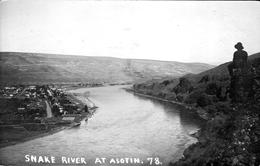Robert "Bob" Bracken was the first non-Indian to settle permanently in what soon became Asotin County. He arrived late in 1861 when the area was still part of an Indian reservation. Bracken engaged in stock ranching in Asotin County for more than 40 years, living in various places throughout the county. He later became "the authority" of the history of Asotin County in the 1860s, when it was mostly "Indian Territory." Bracken died in 1906, but several landmarks in Asotin County still bear his name.
Arriving in Indian Country
Robert "Bob" Bracken was born about 1841, but nothing is known of his early years. His trail picks up in California in 1861 when, at about the age of 20, he left the state with a number of prospectors, bound for newly discovered gold mines in Idaho. In the autumn of 1861 Bracken arrived at the mouth of Alpowa Creek on the Snake River (about nine miles west of present-day Clarkston) and wintered there. At the time of his arrival, the area was an Indian reservation.
Bracken is known as the "first settler of Asotin County," but this is technically not correct; Sam Smith had actually set up a small hotel and store near the same spot on Alpowa Creek perhaps four or five months before Bracken's arrival. Smith stayed only briefly, however, and it appears that Bracken was probably the second settler in the future Asotin County. There is no dispute that Bracken was the first permanent non-Indian settler of Asotin County.
Bracken arrived at his winter quarters at the mouth of Alpowa Creek just in time to experience one of Eastern Washington's harshest winters in recorded history. He recorded that snow stayed on the ground for three months and reached a depth of 28 inches. He also reported that "out of one band of 800 horses and mules, over 200 were lost" as a result of the extreme weather conditions.
In 1862 Bracken moved to a point about eight miles south of present-day Asotin. That same year the Indian reservation was moved farther east, into Idaho. But the area remained "Indian Territory" through much of the 1860s, with only a handful of scattered non-Natives settling in what would later become Asotin County. In his later years, Bracken would share their stories and the early history of the county more readily than he would discuss his own history.
Raising Sheep and Horses
Bracken lived in various locations in Asotin County from the 1860s until his death in 1906, primarily on or near the upper reaches of Asotin Creek or near the Grande Ronde River in the southern part of the county. He had flocks of sheep for a number of years, but is primarily remembered for raising horses. A contemporary recorded that "the Bracken brand was called the Lightning Rod, a burn about a foot long on the stifle" (a large joint on a hind leg) (Weatherly).
Bracken took a Nez Perce wife, "Mary," apparently fairly early in his stay in the county. They had no children. Perhaps because of his wife, Bracken was said to be quite popular with the Native Americans in the area.
By the 1890s, Bracken was living on Asotin Creek, roughly 15 or so miles southwest of Asotin; at that point he had nine cabins and a large set of corrals to work the range horses. He also had a small general store, although "the inventory probably never exceeded two hundred dollars" (Weatherly). A contemporary who knew Bracken in the late 1890s described him as "slow of speech and action. He went armed with a .45 Colt single action pistol always" (Weatherly).
A Pioneer's Sad End
Bracken died a sad death. By the early 1900s many of his friends had died and he became a "sick, eccentric, broken and forgotten old man" (Weatherly). In the winter of 1906 one of his feet froze and he subsequently contracted gangrene in the foot. In May 1906 he was found dead in a fence corner on his property. He had lain down on his stomach and shot himself behind the right ear with his .45 Colt pistol. He was reported to be 65 years of age.
Bracken was buried in the small Asotin Creek Cemetery, known by some as "Bracken Cemetery." This tiny graveyard, located about 14 miles southwest of Asotin, has long since disappeared. But Bracken's name lives on in other landmarks in the west central part of Asotin County: Bracken Point, Bracken Ridge, and Bracken Springs.
Rumors of buried gold at Bracken's last homestead persisted through much of the twentieth century. Asotin County historian Robert Weatherly (1921-1997) wrote in the 1980s, "There are even searchers equipped with metal detectors checking the area once in awhile now." No gold has ever been found.

